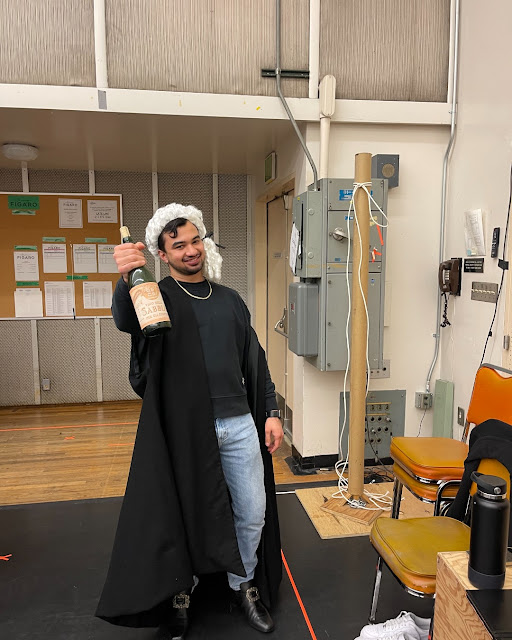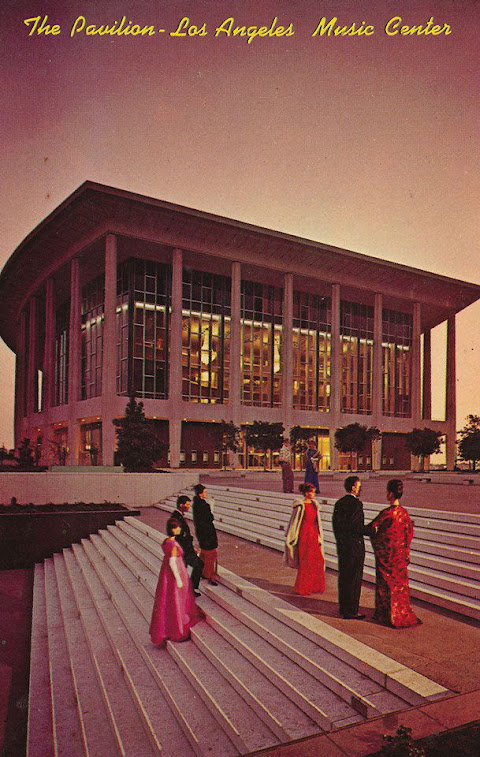The Music Center pages: Ahmanson Theatre | Dorothy Chandler Pavilion | Disney Hall | Redcat | Mark Taper Forum |
Opened:
December 6, 1964 as The Pavilion at L.A. Music Center with Zubin Mehta conducting the L.A. Philharmonic in “Fanfare” by Richard Strauss. It was also called the Memorial Pavilion. The Times reported that opening
week shows included the Count Basie Orchestra, Van Cliburn and Frank
Sinatra. Sinatra was subbing for Nat King Cole, who was sick. There had
been a dedication ceremony on September 27 with Bob Hope as emcee. Photo: Bill Counter - 2018
Phone: 213- 972-7211 Website: www.musiccenter.org | on Facebook
The Music Center campus is a Los Angeles County operation. The Board of Supervisors later renamed the theatre the Dorothy Chandler Pavilion in honor of Dorothy Buffum Chandler, the prime instigator and fundraiser for the project. When the Pavilion first opened it largely replaced the 1906 vintage Philharmonic Auditorium.
Broadway shows that once might have played the Philharmonic or the
Dorothy Chandler are now booked at the Ahmanson, a venue that opened in
1967.
The L.A. Philharmonic moved over to Disney Hall in 2003. The Oscar telecast, now at the Dolby Theatre, was done for decades at the Dorothy Chandler, alternating years with the Shrine Auditorium.
Current programming at the Dorothy Chandler includes the L.A. Opera and
Glorya Kaufman Dance seasons as well as other events.
Architect: Welton Becket. Much of the decor was by Tony Duquette and Elsie de Wolf.
Seating: 3,197. It's a three-balcony house. The levels above the main floor are referred to as the Founders Circle, Loge, and Balcony.
Stage data:
Proscenium width: 58'
Stage depth: 64'
Upstage "bustle": 172' wide x 40' deep
Stage wall-to-wall: 169'
Grid height: 90'
Counterweight system: 108 sets operated at stage level stage right. Battens can be used as 45' lengths or are 65' when extensions are added to the ends. Sets have 7 lift lines. Tension blocks are in a well about 10' below stage level. In addition, there are two underhung sets with 8 lift lines each below the beam at the backwall. A few underhung sets are positioned in the upstage bustle beyond the back wall.
Flyfloor: Stage right about 40' up. In addition, there are many other catwalk levels so that arbors can be loaded from any of eight different heights.
Stage left storage area: 40' wide x 60' deep
Dressing rooms: There are 10 rooms either at stage level or on the mezzanine level above. There's dressing room space for 200 performers in the basement in addition to musicians rooms and storage.
The new building was covered in a December 1964 issue of Life. Thanks to Damon Wolf for locating this for a post for the Lost Angeles Facebook group.
Lobby areas:
The east side of the Plaza Level lobby. Entrances to the house left side of the main floor are off to the right. Photo: Bill Counter - 2018
The lobby at the Founders Circle level in 1968. Thanks to Alison Martino for the photo. It once appeared as a post on her Vintage Los Angeles Facebook page but seems to have vanished from that platform.
The Founders Circle lobby from house right. This performance and reception area is now called Stern Hall. Photo: Bill Counter - 2018
The Founders Room off the house right side of the lobby. Two of the three chandeliers in the room were used in the 1938 MGM film "The Great Waltz." When the decorator, Tony Duquette, decided that they would be used for this room but three were needed, another was built to match. Photo: Bill Counter - 2018
The inner lobby at the Founders Circle level. The auditorium is off to the right. Through the doors at the end is the Oval Lounge. Photo: Bill Counter - 2018
The Oval Lounge on the house left side of the lobby at Founders Circle level. Restrooms are down at the far end. The auditorium is off to the right. Photo: Bill Counter - 2018
A look east from the Loge Level lobby. That's City Hall through the left window at the far end. Photo: Bill Counter - 2018
A look down from the lobby at Balcony Level in 1967. Thanks to Richard Wojcik for the photo from his collection. It's on the Vintage Los Angeles Facebook page.
The auditorium:
A peek down at the main floor. Photo: Bill Counter - 2018
The view from the front of the stage. Photo: Mike Hume - 2019
In the wings downstage left looking onstage. Photo: Bill Counter - 2018
Downstage left with an emptier stage. Photo: Bill Counter - 2019
The view across to stage right. Photo: Bill Counter - 2019
Downstage left looking through the open door into the upstage bustle. Photo: Bill Counter - 2018
In the upstage bustle looking toward its back wall. Photo: Bill Counter - 2018
In the bustle looking back across to stage left. Photo: Bill Counter - 2018
Looking down right with an emptier stage. Photo: Bill Counter - 2019
A look at how the lift lines from those two sets within the upstage "proscenium" are terminated. Photo: Bill Counter - 2019
Looking into the pit for the tension blocks, about 10' below stage level. Photo: Bill Counter - 2019
The view back across to stage left. Yes, the place is huge! Photo: Mike Hume - 2019
A closer view to stage left. Photo: Bill Counter - 2019
Into the house from up right. Photo: Bill Counter - 2019
The auditorium from up center. Photo: Mike Hume - 2019. Thanks, Mike!
More exterior views:
A 1963 construction view by an unknown photographer. We're looking south toward the Pac Bell microwave tower and the Minnewaska, a building that would burn a year later in a suspicious fire.
A February 1964 construction view. Thanks to Richard Wojcik for sharing the photo from his collection. It was a post on the Facebook page Vintage Los Angeles. Richard notes that the DWP Building to the left opened in 1965.
A c.1965 postcard view. Thanks to Noirish Los Angeles contributor Ethereal Reality for locating the card. The DWP building, a design by the A.C. Martin Company, opened in 1965.
7,000 fans were in line to buy tickets for "Hello, Dolly!" on August 30, 1965, the day the boxoffice opened. The show, starring Carol Channing, opened September 14. It's a photo in the Herald Examiner collection of the Los Angeles Public Library.
A look south on Grand in September 1976. It's a photo from the Richard Wojcik collection appearing on the Vintage Los Angeles Facebook page.
The Dorothy Chandler Pavilion from Disney Hall. Thanks to Hunter Kerhart for his 2014 photo. Keep up with his latest explorations: hunterkerhart.com | on Flickr
A shot looking
east on 1st St. toward Hope from "Cannonball!" (New World Pictures,
1976). Thanks to Tommy Bernard for sharing 33 great L.A. area
shots from the film paired with recent views in a post for the Facebook
group Historic Film Locations. It's a
cross-country race with big prize money at stake. David Carradine
stars. Also featured are Bill McKinney, Veronica Hamel, Gerrit
Graham, Robert Carradine, Belinda Belaski, Judy Canova and many, many making cameos. Paul Bartel directed. The cinematography was by Tak
Fujimoto. Also see Tommy's recent matching shot of this view.
More information: Visit Mike Hume's fine page about the Music Center on his Historic Theatre Photography site for more photos, including many backstage views.
On his site, Mike has a pdf of "A Contemporary Expression of Classic Architecture," a four page article by Welton Becket discussing the design of the theatre that appeared in the December 6, 1964 issue of the L.A. Times. Also on the site are a floorplan and section.
See Nicholas Beyelia's "All About Eva: Los Angeles Hosts the American Premiere of the Musical, Evita," a 2019 article on the Los Angeles Public Library website.
Curbed L.A. had a nice April 2014 50th anniversary story with a history and photos from the Los Angeles Public Library's collection.
The Music Center pages: back to top - Dorothy Chandler Pavilion | Ahmanson Theatre | Disney Hall | Redcat | Mark Taper Forum |
| Downtown: theatre district overview | Hill St. and farther west | Broadway theatres | Spring St. theatres | Main St. and farther east | downtown theatres by address | downtown theatres alphabetical list |
| Westside | Hollywood | Westwood and Brentwood | Along the Coast | [more] Los Angeles movie palaces | the main alphabetical list | theatre history resources | film and theatre tech resources | theatres in movies | LA Theatres on facebook | contact info | welcome and site navigation guide |












































































No comments:
Post a Comment